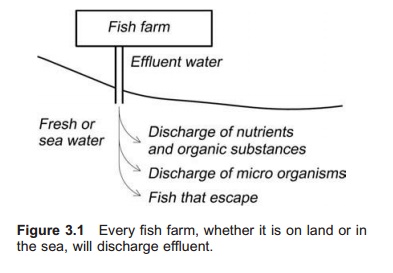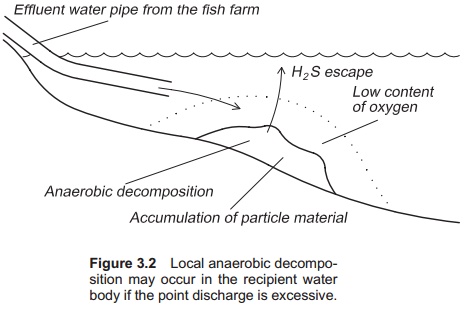Chapter: Aquaculture Engineering : Water Quality and Water Treatment: an Introduction
Outlet water
Outlet water
All outlet water discharged from aquaculture facilities
can present environmental problems which create an imbalance in the ecosystem
in the recipient water body. This is especially important when the outlet
water is discharged into freshwater. Freshwater recipient water bodies are of
limited volume, whereas the sea represents an infinitely large water body;
therefore the consequences of a discharge into a freshwater recipient, such as
a small lake, will be much greater for both open and closed production units.
The effluent discharged from a fish farm can contain three
classes of pollutant (Fig. 3.1):
· Nutrients and organic matter
· Micro-organisms
· Escaped fish

The quantity of nutrients and organic matter dis-charged
depends on the amount of feed used and farm management practices. The nutrient
content in the feed must be optimal for the fish, and as much as possible must
be available to and taken up by the fish. The amount of feed supplied must be
optimal in relation to appetite, so that feed loss is avoided.
Discharge of nutrients to the recipient water body will
result in increased algal growth leading to eutrophication and imbalance in the
recipient ecosystem. Discharge of too much organic matter to the recipient
water body may result in lack of oxygen during the night as a result of
decomposi-tion. Local accumulation of fish faeces in the recipient water body
may cause anaerobic decom-position, possibly accompanied by release of
hydro-gen sulphide (H2S) which is toxic for small animals and fish (Fig. 3.2).
This shows the importance of having an adequate water current at the point
where the discharge is released.

The larger concentration of biological material in a
restricted volume compared to the case in natural conditions means that
possibilities for disease out-breaks in a fish farm are greater than in the
wild. The effluent water may therefore also contain a higher concentration of
pathogenic micro-organisms such as parasites, bacteria, viruses and fungi, that
can cause disease in the fish population. This may again have significant
consequences for the wild fish in the recipient water body. If there are
possibilities for ‘short circuiting’, the fish farm may function as a facility
for increasing the concentra-tion of pathogens (Fig. 3.3). For land-based fish
farms this can be illustrated with pathogens that are ejected in the effluent
water from the farm and are

taken in again with the inlet water. This also shows the
importance of not having these pipes too close to each other. The best
arrangement is to have them in different water bodies, or to treat either the
inlet or the outlet water. Fish that migrate can also be a host for
transporting micro-organisms up rivers, meaning that short circuiting also can
occur here. Migration obstructions in the river may be a solution.
Moving aquatic organisms from one farm to another may, via
the water used for transport, bring new micro-organisms to the recipient farm.
The result can be an outbreak of disease on the fish in the recipient farm.
Some wild stocks may, through natural evolution, have developed natural
immu-nity against some pathogenic micro-organisms while others may represent a
large threat. An example of this is the salmon parasite Gyrodacty-lussalariswhere the Atlantic salmon in a few rivershave
developed immunity, whereas in most rivers the stocks have no immunity. When
moving fish containing such micro-organisms between rivers, or between farms
with outlets to different recipients, the consequences can therefore be fatal.
Treatment of the effluent water is absolutely necessary in such cases.
Escape of fish or other aquatic organisms from farm
conditions may also present environmental problems, except where local stock
that not has gone through to a breeding programme is used on the farm. If the
stocks have gone to a centralized breeding programme where mixing of local
stocks from different districts occurs, or much more seriously, if genetic
manipulations have been per-formed, there may be significant consequences
attending escapes. The fish farming industry has benefitted greatly from
national breeding pro-grammes; for example, growth rates and feed uti-lization
have been improved. What can happen when several fish escape from a farm? One
possibility is that they can establish
their own stock in the recipient water body. This may
result in competition for feed and habitat with the naturally occurring stocks.
Another possibility is that they can interbreed with the local stocks and
create unwanted hybrids. Even if no interbreeding occurs the escaped fish can
destroy the breeding grounds or breeding nests of the wild stocks. Of course,
none of this is wanted and therefore is it very important to try to avoid
escape of fish and other aquatic organisms from farm conditions.
Related Topics